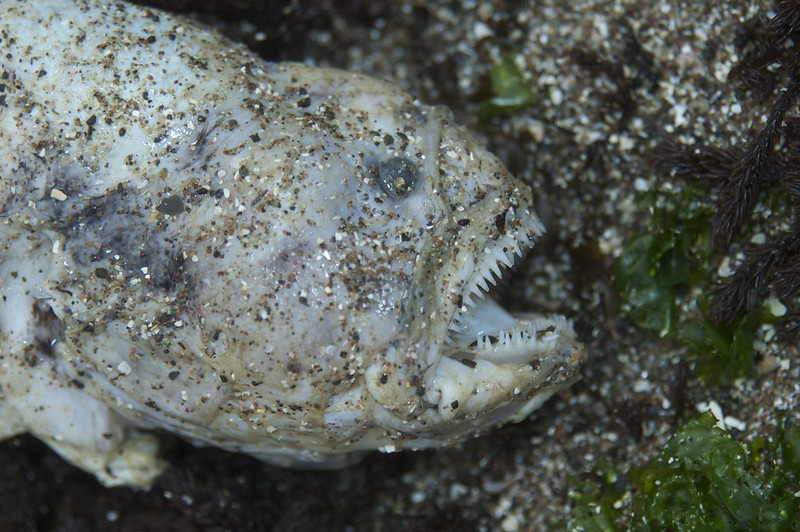
Wolf Eel Facts
- This amazing denizen of the depths is most frequently referred to by the deceptive common name of the Wolf Eel. For the moment, this creation of Nature and evolution has no other broadly accepted general title. Though not unknown, that’s uncommon.
- Within scientific circles, however, it’s likely better known by its formal moniker. That name, though, remains virtually impossible for the layperson to pronounce. That’s because this marine marvel bears the official appellation of the Anarrhichthys ocellatus.
- The creature received that complex name due to the efforts of the American ichthyologist, William Orville Ayres. He recorded the first official recognition of the fish as a separate and distinct species. That scientifically notable event occurred in 1855.
- It distinguishes itself in many ways. One of these, however, pertains to its classification. That’s true since it represents the only member of its genus. The animal further stands out because of the fact that, despite the name, it’s not actually a true eel.
- Fortunately for the Wolf Eel, it appears to be maintaining a population base that’s both stable and sufficent. That pleasant fact also seems to hold true throughout the entirety of its native range. the IUCN thus currently lists the fish as Least Concern.
- The wonder nevertheless does face several potential threats to its continued existence, at least. Most of these stem directly from the actions of humans. They include the same perils faced by many species, namely the dual threat of habitat loss and climate change.
Related Articles
Wolf Eel Physical Description
The astounding Wolf Eel perfectly embodies the definition of different. Yet that very difference captivates many people fortunate enough to encounter one. Impressively, the animal does not do so simply due to its distinctive appearance, but also because of its size.
It’s also worth noting that this fish follows a pattern common to many forms of animal life on the planet. That lies in the fact that it displays a certain degree of the physiological trait of sexual dimorphism. In its case, this characteristic manifests itself in a structural difference.
Otherwise, individuals of both genders of the fish remain virtually indistinguishable to the untrained eye. Fully mature specimens typically attain a length measuring approximately 94 in (2.4 m). These same fish also average roughly 41 lb (18.4 kg) in total weight.
It differs from true eels due to the structure of both their gill slits and pectoral fins. The former develop in pairs, unlike actual eels. The latter also does the same. Combined with their pure size, these serve to create a striking appearance for this product of evolution.
Individuals of both sexes of the Wolf Eel continue their similarity to each other in their coloring. When young, this consists of a dark orange, with large dark spots on the back of the body. Adults, though, present a random mixture of gray, brown, and dark olive shades.
It also has powerful jaws, filled with numerous small, sharp teeth. The gender-based difference, however, appears on the head of the creature. That’s because males of the species possess large lips and a protuberance on the upper part of the head that females lack.
- Kingdom: Animalia
- Phylum: Chordata
- Class: Actinopterygii
- Order: Scorpaeniformes
- Family: Anarhichadidae
- Genus: Anarrhichthys
- Species: A. ocellatus
Wolf Eel Distribution, Habitat, and Ecology
The visually impressive Wolf Eel evolved as native to a moderately broad section of the oceans of the world. The precise nature of that zone of habitation might be a surprise to some people, though. It’s nevertheless a region known for containing many natural wonders.
That’s because it developed as endemic to a section of the northern Pacific Ocean. That habitat range extends from the Sea of Japan to the Aleutian Islands, and to the coast of California, in the United States, in North America. It’s unknown if it ever lived beyond this.
Yet, within that area, the highly evolved creature developed very precise requirements for its choice of habitat. This holds true due to the fact that the fish lives only in relatively shallow waters. The maximum known depth at which it appears only equals 741 ft (226 m).
As a result, this remarkable species lives almost exlusively in regions located comparatively close to shore. It also displays further habitat preferences, though. Individuals typically make their home within various crevices, caves, areas with stony bottoms, and rocky reefs.
Despite its relatively large size and name, the intriguing Wolf Eel rarely becomes aggressive, though they’re frequently curious. Males and females sometimes mate for life, and sharing caring for the young. This even extends to taking turns leaving their shelter to feed.
It primarily consumes various invertebrates possessing hard shells. This typically includes such available prey as sea urchins, crustaceans, mussels, and clams. It also consumes the occasional small fish. Its own predators include harbor seals, sharks, and even larger fish.
Species Sharing Its Range
Check out our other articles on 5 Intriguing Insects of Greece, Eastern Gray Squirrel, Namib Desert, Franklin’s Bumblebee, Great Potoo, Appalachian Avens, Aldabra Giant Tortoise
